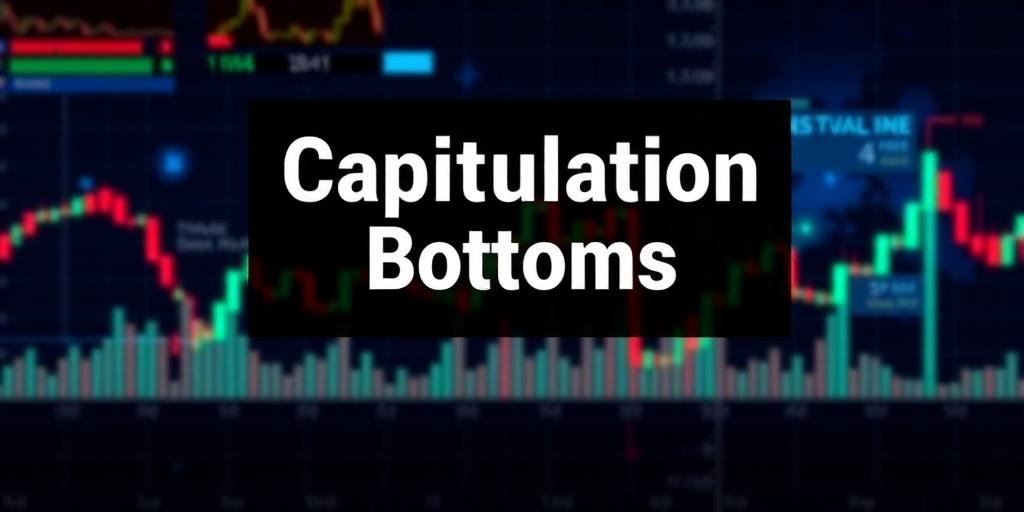Identifying Capitulation Bottoms Through Distinctive Chart and Volume Signatures
In financial markets, identifying when a security or index has reached its absolute bottom is a pursuit laden with uncertainty. However, the concept of 'capitulation' offers a framework to recognize potential turning points. Capitulation, characterized by widespread investor surrender and panic selling, often leaves distinctive footprints on price charts and volume indicators. This post delves into how these signatures can be identified, providing a guide for investors and traders.
Understanding Capitulation
Capitulation occurs when a significant number of investors, usually after a prolonged period of price declines, give up hope and sell their positions regardless of price. This event is driven by fear, margin calls, or the need to meet liquidity requirements. The resulting selling pressure is intense and unsustainable, often leading to a sharp reversal once the selling is exhausted.
Distinctive Chart Patterns
1. Waterfall Decline:
Prior to capitulation, the price chart typically exhibits a steep and accelerating downtrend, resembling a waterfall. Each successive wave of selling pushes the price lower, eroding investor confidence.
2. V-Shaped Reversal:
The hallmark of a capitulation bottom is a rapid and decisive reversal of the prior downtrend. Prices may plummet to new lows, but this is quickly followed by a strong rally. This V-shaped pattern indicates that the intense selling pressure has been absorbed, and buyers are stepping in.
3. Exhaustion Gap:
An exhaustion gap is a significant price gap that occurs near the end of a downtrend. It represents a final surge of selling that fails to sustain itself. This gap is often filled quickly, signaling the end of the decline.
Volume Signatures
1. Climax Volume:
Capitulation is almost always accompanied by an extraordinary spike in trading volume. This climax volume reflects the panic selling as investors rush to exit their positions. The volume surge should be significantly higher than the average trading volume.
2. Follow-Through Volume:
Following the initial volume climax, it's essential to observe the subsequent volume patterns. A healthy recovery should be accompanied by strong, increasing volume as the price rallies. This confirms that buyers are genuinely interested in the security.
3. Selling Pressure Exhaustion:
Look for evidence that selling pressure is waning. This can be observed through indicators like the Accumulation/Distribution Line, which should start to trend upward, signaling that buyers are gaining control.
Confirmation Signals
While chart and volume patterns can provide valuable clues, it's essential to seek confirmation from other indicators and sources:
- Sentiment Indicators: Monitor sentiment surveys and social media to gauge investor sentiment. Capitulation often coincides with extreme bearish sentiment.
- Breadth Indicators: Examine market breadth indicators like the Advance/Decline Line to ensure that a broad range of stocks are participating in the recovery.
- Fundamental Analysis: Assess the underlying fundamentals of the security or index. A capitulation bottom is more likely to occur if the fundamentals are sound and the price decline is primarily driven by fear.
Risk Management
Identifying capitulation bottoms is inherently speculative. Implement robust risk management strategies to protect your capital:
- Stop-Loss Orders: Place stop-loss orders below potential support levels to limit your downside risk.
- Position Sizing: Allocate a smaller portion of your capital to trades based on capitulation signals.
- Diversification: Diversify your portfolio to reduce the impact of any single trade.
Conclusion
Recognizing capitulation bottoms can provide astute investors with opportunities to enter positions at attractive prices. By combining the analysis of distinctive chart patterns with volume signatures and seeking confirmation from other indicators, you can enhance your ability to identify these turning points. However, always remember that no strategy is foolproof, and effective risk management is crucial.









